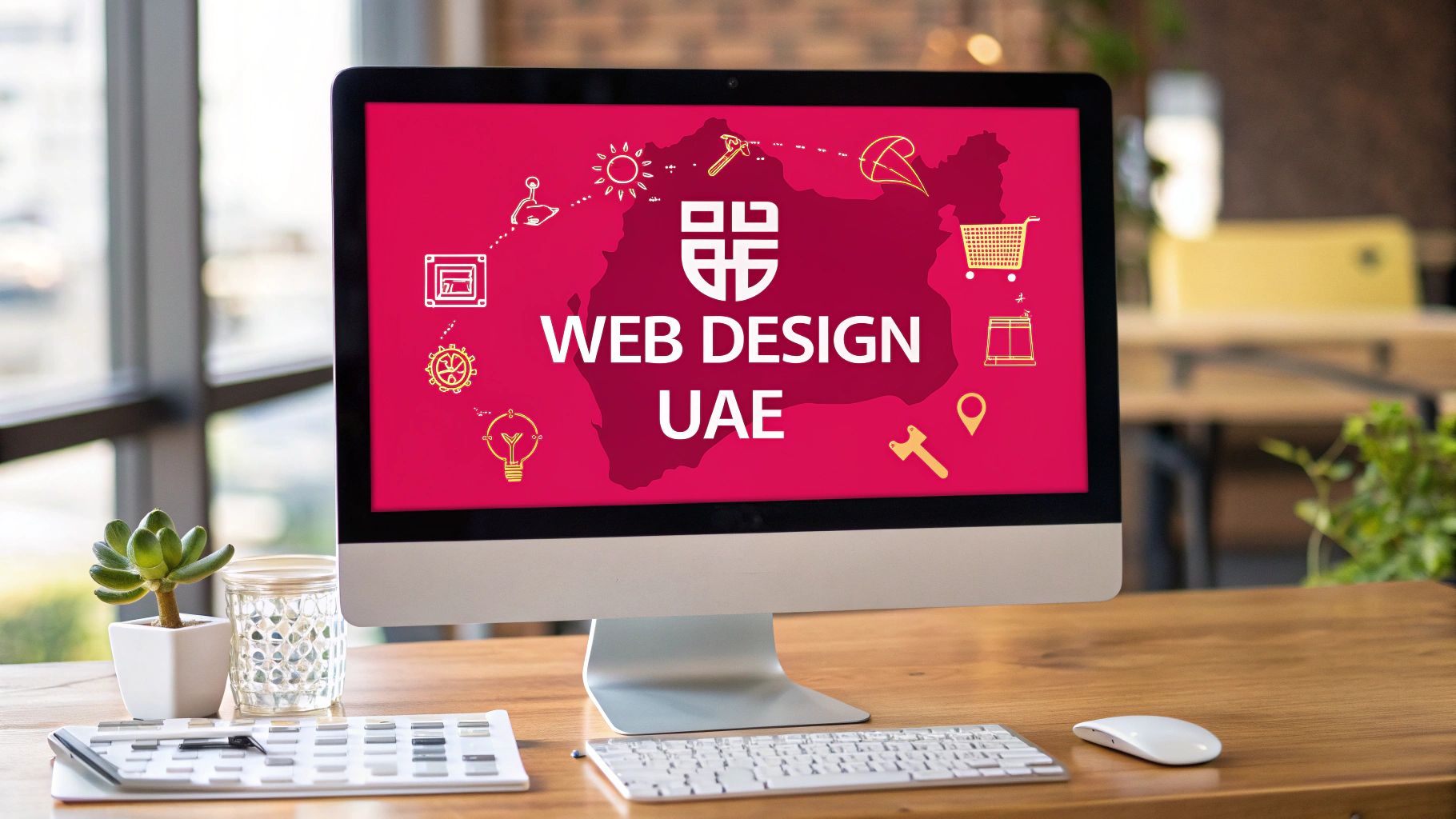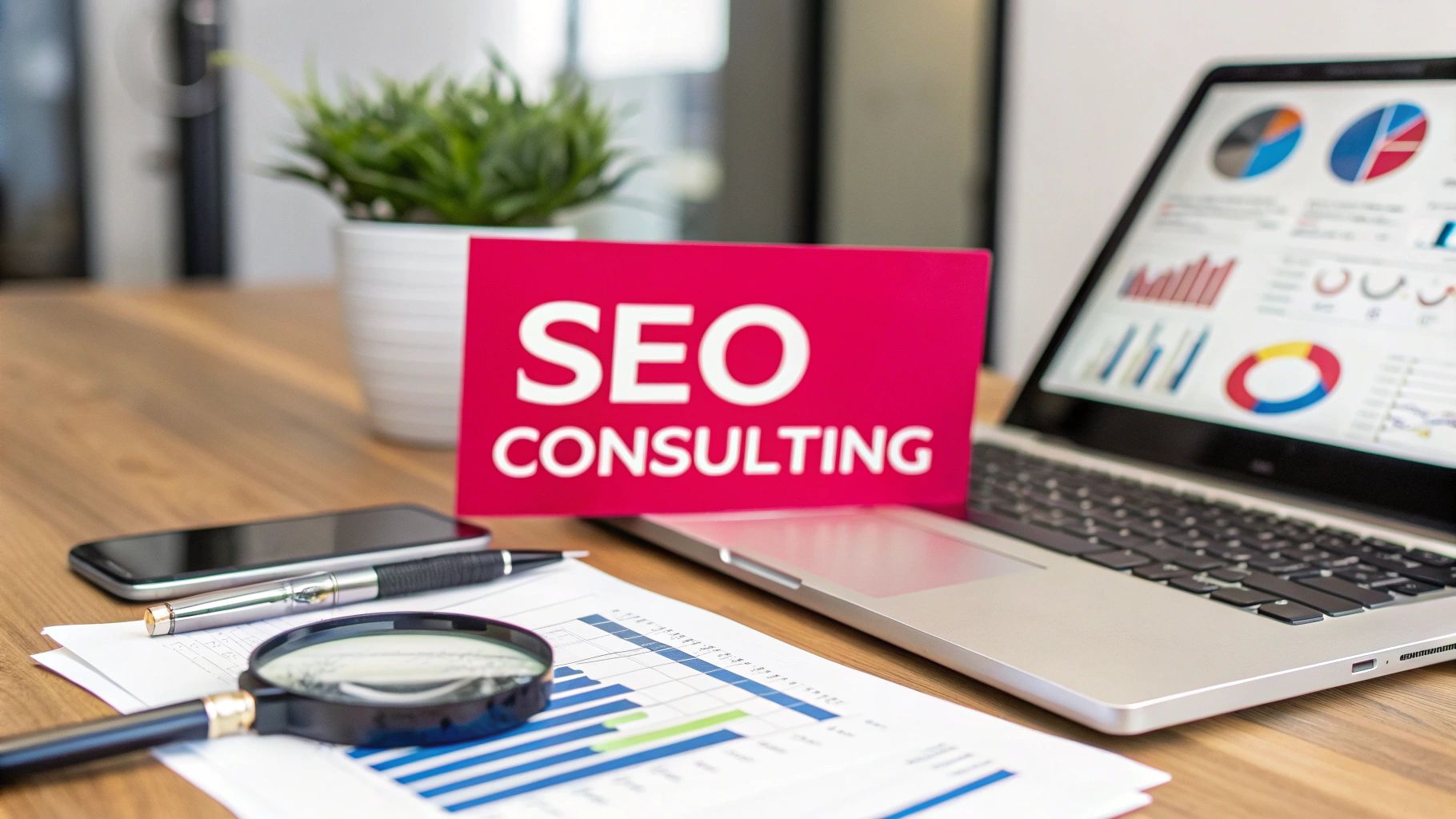A solid ecommerce web design uae strategy is about so much more than a pretty layout. It’s about creating a truly localised, user-focused experience that turns casual visitors into repeat customers. This means blending a mobile-first design philosophy with secure, familiar payment options and content that genuinely connects with the local culture. Nail this, and you'll meet the high expectations of the region's shoppers.
Foundation for Ecommerce Success in UAE

If you're looking to build a high-performing online store in the UAE, you have to start with a deep understanding of this unique market. A generic, one-size-fits-all template just won’t cut it here; the audience is far too sophisticated for that. The real foundation for your success lies in a strategy built from the ground up to reflect local consumer habits and preferences.
The UAE’s digital economy is absolutely booming. The e-commerce market is sitting at around USD 79.94 billion in 2024 and is on track to hit a staggering USD 270.5 billion by 2032. This explosive growth, fuelled by secure payment adoption and widespread smartphone use, highlights a massive opportunity for businesses that get their online presence right from day one.
Prioritise a Mobile-First Approach
Let's be clear: the UAE is a mobile-first market, boasting one of the highest mobile penetration rates on the planet. This isn't just a suggestion; it's a rule. Your website must be designed for the small screen first and then adapted for desktop—not the other way around.
What does a real mobile-first design look like in practice?
- Responsive Layouts: Your site needs to fluidly adjust to any screen, providing a flawless experience whether on a smartphone, tablet, or desktop.
- Thumb-Friendly Navigation: Think about how people hold their phones. Menus, buttons, and links have to be easy to tap with a thumb, which helps avoid frustration and accidental clicks.
- Optimised Performance: Mobile users are impatient. Fast load times are non-negotiable. You'll need to compress your images and streamline your code to keep bounce rates down.
Build Trust from the First Click
In online retail, trust is everything. Shoppers in the UAE are savvy and will actively look for signals that a business is legitimate and secure before they even think about making a purchase. You have to weave these trust signals right into the fabric of your design.
For a deeper dive, our comprehensive post on https://grassrootscreativeagency.com/ecommerce-website-design-uae/ is a great resource.
A successful e-commerce site in the UAE is built on a foundation of trust, speed, and cultural relevance. Neglecting any of these three pillars means leaving revenue on the table and giving competitors an easy advantage.
To get your online venture off to a strong start, it's worth understanding the practical steps involved in setting up an ecommerce website. This initial setup is your chance to implement those crucial trust signals—like displaying clear contact information, featuring customer reviews prominently, and making sure your payment gateways are visibly secure. Together, these elements create the reassuring experience customers need to feel confident buying from you.
Designing a User Experience That Clicks with UAE Shoppers
If you want to succeed in the UAE, you can't just translate your website and call it a day. The user experience has to feel like it was built from the ground up for the local audience. With a staggering 75% of online traffic in the region coming from smartphones, a mobile-first approach isn't a suggestion—it's the only way forward.
Think about how people actually use their phones here. They're often browsing with one hand, so thumb-friendly menus and large, tappable buttons are non-negotiable. Product galleries need big, beautiful images that show off the details shoppers care about. One of my favourite examples is the Dubai fashion brand NoorCloth. They simply redesigned their homepage slider to feature better-quality, mobile-focused imagery and saw their bounce rate plummet by 30%.
Little things make a huge difference, like sticky 'buy' buttons that stay visible as a user scrolls. It’s all about removing friction.
Before you even think about writing a line of code, you need to get prototypes in front of real people. This is where you iron out the kinks in your layout, especially when dealing with the complexities of Arabic. You can test how your Arabic copy fits and how the right-to-left (RTL) flow feels to a native speaker. To get this right, you really need to dive into some essential user research methods. Getting that early feedback allows you to refine things like button labels, maybe swapping a formal translation for a more common, everyday Arabic phrase. That’s how you build a genuine connection.
Getting the Bilingual Balance Right
Handling both English and Arabic on the same site is a design challenge, but it's one you have to master. It’s not just about flipping the text direction; you need to think about how different fonts and line heights affect readability in both scripts.
GulfGlam, a regional beauty retailer, does this beautifully. Their product pages switch direction seamlessly, so users aren't thrown off by jarring, mixed-up layouts. A simple table can be a lifesaver for your design team to keep things consistent.
| Element | English Layout | Arabic Layout |
|---|---|---|
| Text Direction | Left to right | Right-to-left |
| Font Choice | Sans-serif (e.g., Helvetica) | Naskh or Thuluth styles |
| Button Position | Typically bottom right | Typically bottom left |
| Progress Flow | Left to right | Right-to-left (reversed) |
This little checklist helps ensure nothing gets lost in translation, literally.
Building Trust with Imagery and Badges
The visuals you choose are just as important as the text. Stock photos of Western families or generic cityscapes won't cut it. Shoppers in the UAE respond to authenticity and visuals that reflect their own lives and social norms—think modest fashion, family-centric scenes, and local settings.
I saw this work wonders for SinaiTech, an electronics retailer in Dubai. They ditched their generic product shots and replaced them with photos of local influencers actually using their gadgets. The result? Their add-to-cart rate jumped by 18%. It’s proof that authenticity sells.
Beyond imagery, trust badges are your best friend at the checkout. Displaying the official UAE e-commerce compliance mark, along with familiar icons for Visa, Mastercard, and local payment wallets, instantly boosts a shopper's confidence.
- Official compliance marks are a must for reassuring new customers.
- Payment security icons show you’re a legitimate, secure business.
- Clear links to your return policy demonstrate transparency and build trust.
Prototyping and Testing: Your Secret Weapon
I can't stress this enough: test, test, and test again. Rapid prototyping sessions will save you so much time and money down the line. We’ve seen usability tests uncover everything from confusing product filters to unclear category labels, cutting redesign costs by as much as 40%.
Get an interactive mockup built in a tool like Figma or Adobe XD that can simulate RTL layouts. Then, grab at least five participants from different emirates to get a good mix of perspectives. Give them simple tasks, like "find the return policy" or "apply this promo code," and watch where they struggle.
This doesn't have to be complicated. Just a few short sessions, either remote or in-person, will give you a goldmine of feedback to work with.
My experience shows that simply clarifying your category labels can reduce bounce rates by up to 25% on UAE e-commerce sites. It’s a small change with a massive impact.
Your calls-to-action (CTAs) need this attention, too. Use culturally relevant phrasing like 'اشترِ الآن' alongside 'Shop Now'. And make sure the buttons themselves adapt to RTL layouts, flipping their alignment to feel intuitive for Arabic readers. A fashion site, Dubai SouqStyle, saw a 22% increase in clicks just by adjusting their purchase buttons to match local reading patterns.
The Final Pre-Launch Check
Before you go live, run through one final checklist to make sure you've covered all your bases.
- Double-check mobile navigation and tap areas.
- Get a native speaker to validate all bilingual text.
- Confirm all imagery is culturally appropriate and reflects UAE values.
- Test your CTA placement in both LTR and RTL layouts.
- Get final sign-off from at least three UAE-based test users.
- Ensure all trust badges are clearly visible near the checkout.
With these steps complete, your storefront will be perfectly positioned to not just attract, but truly connect with local shoppers, no matter what language or device they’re using.
Tailoring Your Platform for the Local Market
Choosing your e-commerce platform is one of the most critical decisions you'll make. Think of it as the digital foundation of your entire business—it impacts everything from your day-to-day operations to how easily you can grow down the road. A solid ecommerce web design uae strategy hinges on a platform that doesn't just work for you today but is ready for where you want to be tomorrow.
Localisation goes far beyond simple translation. It's about truly understanding the local market. For instance, what product categories are people actually buying? In the UAE, apparel is a massive player, with over 6,520 online stores making up 17.7% of the entire e-commerce scene. You can dive deeper into the numbers with this insightful market report.
Knowing this kind of information helps shape your platform choice. If you're selling fashion, you'll need features like advanced filtering for size, colour, and style. But if you're an electronics retailer, your priority might be detailed specification tables and product comparison tools. Your platform has to support what your customers need.
Selecting the Right E-commerce Platform
The platform you go with will define your ability to customise, scale, and integrate with other tools. Let's break down three of the most popular choices to help you figure out which one fits your business best.
Comparing E-commerce Platforms for the UAE Market
Picking the right platform can feel overwhelming, but it often comes down to balancing your technical skills, budget, and long-term vision. This table breaks down the core differences between Shopify, WooCommerce, and Magento (now Adobe Commerce) to help guide your decision.
| Feature | Shopify | WooCommerce | Magento (Adobe Commerce) |
|---|---|---|---|
| Ease of Use | Very user-friendly, ideal for beginners with a simple setup process. | Moderate learning curve, requires WordPress knowledge. | Complex, often requires a dedicated development team. |
| Cost Structure | Monthly subscription model plus transaction fees. | Free core software, but costs for hosting, themes, and plugins add up. | Higher upfront and ongoing costs, suited for large enterprises. |
| Customisation | Good, but limited by the platform's structure and app ecosystem. | Highly customisable with extensive access to code and thousands of plugins. | Extremely flexible, offering nearly limitless customisation options. |
| Scalability | Excellent for small to large businesses with Shopify Plus for enterprise needs. | Scalable, but performance can depend heavily on hosting and optimisation. | Built for high-volume, enterprise-level operations with robust scalability. |
| Local Integrations | Strong app store with integrations for local payment gateways and logistics. | Wide range of plugins available for UAE-specific payment and shipping providers. | Powerful integration capabilities but may require custom development. |
Each platform has its place. For a new Dubai-based fashion boutique, Shopify is often a perfect match. Its intuitive interface and app store make it straightforward to integrate local payment gateways like Telr and shipping partners like Aramex, all without needing a developer on standby.
On the other hand, a large electronics distributor with a complex inventory and B2B sales channels would probably lean towards Magento. Its powerful architecture is built to handle thousands of products and complex pricing rules, giving a large-scale operation the raw power it needs.
The chart below gives you a clear picture of the incredible growth happening in the UAE's e-commerce market.

This kind of consistent growth, combined with high smartphone use and a quick shift to digital payments, means the technical choices you make right now are more important than ever.
Customising Your Storefront for Key Events
Your platform choice also affects how nimble you can be. A static, unchanging storefront just won't cut it in the UAE, where shopping seasons are driven by major cultural events and holidays. You need the ability to quickly and easily update your site's content for periods like Ramadan, Eid, and National Day.
Imagine you're running a local cosmetics brand. Leading up to Ramadan, you'll want to:
- Launch a special landing page dedicated to curated gift sets.
- Update your homepage banners with imagery and messages that resonate with the season.
- Add a countdown timer to limited-time offers to create a sense of urgency.
This isn't just a "nice-to-have" feature; it's a core part of your sales strategy. A platform like WooCommerce, with its huge library of plugins, makes it relatively simple to add things like promotional pop-ups or build unique landing pages for these campaigns.
A flexible tech stack is your greatest asset. The ability to quickly pivot your site's content and promotions in response to local events can significantly boost engagement and sales, turning seasonal traffic into loyal customers.
In the end, the "best" platform is the one that lets you connect with your local audience authentically. Whether you choose Shopify for its simplicity, WooCommerce for its flexibility, or Magento for its sheer power, let your decision be guided by a clear understanding of your products, your customers, and your vision for growth in this exciting market.
Integrating Payments And Logistics Seamlessly
A stunning site design only takes you halfway there. If checkout feels clunky or shipping options come as a surprise, many shoppers will bail at the last moment. Smooth payment and delivery workflows are at the heart of any successful ecommerce web design uae project.
Your aim? Make wrapping up a purchase feel effortless and secure. That means plugging in local payment methods people actually use and teaming up with couriers who cover every corner of the Emirates. Get this right, and cart abandonment drops significantly.
Choosing The Right Payment Gateways
In the UAE, a one-size-fits-all approach won’t cut it. Credit cards remain popular, but digital wallets and Cash on Delivery (COD) are non-negotiable for many buyers. Make sure your platform supports every preference to maximise sales.
Leading local gateways include:
- Telr: Easy setup, multiple currencies supported—perfect for brands eyeing the region.
- PayFort (an Amazon company): Trusted across the Emirates, with strong fraud protection.
- Checkout.com: One platform for all your payment needs, offering modern dashboards and custom reports.
Don’t overlook COD. Yes, it adds complexity, but skipping it can alienate a large audience. On the flip side, integrating one-click wallet payments like Apple Pay and Google Pay can slice checkout time dramatically. One UAE electronics retailer reported a 30% boost in purchase speed after adding these options.
“A frictionless checkout experience is a powerful trust signal. Familiar, secure payment choices give customers the confidence to click ‘Buy Now.’”
Balance is key. Pair well-known gateways with fast digital wallets and the familiar comfort of COD. This mix covers every type of shopper and keeps dropout rates in check. For a deeper dive into platform capabilities, check out our guide to ecommerce website development in Dubai.
Streamlining Your Logistics And Shipping
Once payment is done, all eyes shift to delivery. Vague or hidden shipping fees are a top reason for abandoned carts. Partner with reliable local couriers like Aramex or Fetchr to build credibility from the moment someone clicks “Order.”
Your logistics setup should deliver:
- Transparent Shipping Rates: Show costs up front—no surprises at checkout.
- Real-Time Tracking: Provide a link so customers can follow their parcel every step of the way.
- Clear Communication: Send automated emails or SMS updates at each milestone: confirmed, dispatched, out for delivery and delivered.
Imagine a Dubai-based gift arriving in Abu Dhabi seamlessly. Immediate order confirmation, a tracking link the next morning and an SMS when the driver is near. That level of transparency turns first-time buyers into repeat customers.
Testing And Optimising Your Flow
Before you go live, test every inch of your payment and shipping chain. Even a small glitch can cost you sales and damage your reputation. Aim for a customer-centric mindset—walk through the process as if you’re buying the product yourself.
Pre-Launch Checkout Checklist
- Process a test transaction with every payment method you support.
- Confirm order confirmation emails arrive promptly and include accurate details.
- Simulate failed payments. Check that error messages are clear and users can retry easily.
- Validate shipping costs for different Emirates and weight brackets.
- Test on mobile devices. Ensure forms are easy to complete on small screens.
This stage isn’t just about hunting bugs. It’s an opportunity to polish every interaction. By stepping into your customers’ shoes, you can smooth out rough edges and ensure your checkout is as seamless as the rest of your beautifully crafted website.
Getting Found and Staying Compliant: SEO and Regulations in the UAE

It’s one thing to build a beautiful, user-friendly website. It’s another thing entirely to make sure people can actually find it—and that you’re operating completely above board. When it comes to ecommerce web design uae projects, getting your legal house in order and building a smart search engine optimisation plan aren't separate tasks. They're two sides of the same coin, absolutely crucial for long-term success.
The UAE e-commerce scene is booming. Sales shot up by 53% back in 2020 and are on track to hit USD 8 billion by 2025. With nearly everyone online and major players like Amazon snapping up local giants like Souq.com, it's a crowded marketplace. Just having a great product isn't enough; you have to be visible.
Think of it this way: a solid legal foundation builds trust and credibility with your customers. A powerful SEO strategy makes sure they can find you in the first place. You can’t have one without the other.
First Things First: Understanding UAE E-commerce Regulations
Before you even think about launching, you need to get your head around the UAE's legal framework. This isn’t just bureaucratic box-ticking. It’s about establishing your business as a credible, trustworthy entity from day one. Get this wrong, and you could be looking at hefty fines and a damaged reputation before you've even made your first sale.
Here are the non-negotiables you need to tackle:
- Business Licensing: You'll almost certainly need an e-commerce licence from the Department of Economic Development (DED) in your emirate. In Dubai, for example, this is often the DED Trader Licence. It’s your official green light to operate online.
- Consumer Protection Laws: The UAE takes consumer rights seriously. Your policies on returns, refunds, and product descriptions must be crystal clear, fair, and easy for customers to find on your site. No hidden clauses or confusing jargon.
- Data Privacy: This is a big one. You are legally required to be transparent about how you collect, handle, and protect customer data. Make sure your privacy policy is up-to-date and compliant.
Nailing these fundamentals sends a strong signal to shoppers that you're a professional and serious business, which can do wonders for your conversion rates.
Building a Bilingual SEO Strategy for a Diverse Market
To truly succeed here, your SEO has to speak two languages: English and Arabic. And I don't mean just running your English keywords through a translator. It’s a much more nuanced game that involves deep keyword research, culturally relevant content, and the right technical setup. To lay a strong foundation, it's vital to grasp the role of keywords in content strategy.
I remember working with a Dubai-based fashion retailer that saw this firsthand. By doing proper Arabic keyword research—understanding local dialects and how people genuinely searched for clothing—they were able to boost their Arabic search traffic by a staggering 45%. They didn't just translate; they localised.
Your bilingual SEO strategy is a direct reflection of your commitment to the local market. A thoughtfully executed plan will not only improve rankings but also build a stronger connection with your entire audience.
From a technical standpoint, getting your bilingual site structure right is key. Here’s what you need to do:
- Clean URL Structure: Use subdirectories like
yourstore.ae/en/andyourstore.ae/ar/. This is the clearest way to tell search engines (and users) which version of the site they're on. - Hreflang Tags: These little snippets of code in your site's header are essential. They signal to Google which language a page is in, ensuring it serves the right version to the right user.
- Separate Sitemaps: Create a unique sitemap for each language version of your site and submit both to Google Search Console. This helps guarantee that all your pages get discovered and indexed properly.
Boosting Your Profile with Local SEO Tactics
Beyond just language, you need to send strong local signals to search engines. A fantastic way to build authority is by earning backlinks from reputable UAE-based publications, popular blogs, and local business directories. Think about partnering with local influencers or sponsoring a community event—these activities can generate positive buzz and high-quality links back to your site.
Another powerful tool in your arsenal is schema markup. By adding this structured data to your product pages, you give search engines detailed information like price, stock availability, and customer reviews. This can lead to "rich snippets" in search results, making your listings pop and enticing more clicks than your competitors.
By weaving these legal and SEO threads together from the very beginning, you’re not just launching a website; you’re building a resilient and highly visible e-commerce business poised for growth in the UAE market. If you're looking for more specific advice, you might find our expert insights on https://grassrootscreativeagency.com/search-engine-optimisation-uae/ helpful.
Measuring Performance and Optimizing After You Go Live
Let’s be clear: launch day is just the beginning. It's the starting gun, not the finish line. A stunning website that doesn't perform, convert, and adapt is little more than a pretty digital brochure. This is where the real work starts—a constant cycle of measuring, learning, and refining that will truly drive your growth.
A solid post-launch strategy is all about ditching guesswork for data. When you set up the right tools, you can turn a flood of raw numbers into a clear story. You'll see exactly how users move through your site, where they get stuck, and what convinces them to buy. For any ecommerce web design uae project aiming for serious, long-term success, this insight is everything.
Getting Your Analytics Toolkit in Order
You can't improve what you don't measure. The very first thing you need to do is get your analytics and user behaviour tools properly set up. These are your eyes and ears, giving you both the hard data and the 'why' behind it.
Think of it as your essential performance kit. At a minimum, you'll need:
- Google Analytics 4 (GA4): This is your command centre. It's non-negotiable for tracking where your visitors come from, who they are, how they engage, and where they drop off in the buying process. It answers the "what" and "how many" questions.
- Heat-mapping Tools: Platforms like Hotjar or Crazy Egg are brilliant. They show you visually where people are clicking, how far they scroll, and where their mouse hovers. This is your qualitative goldmine, answering the "why" behind what the numbers tell you.
- Customer Feedback Surveys: Sometimes the easiest way to find a problem is just to ask. Simple, well-placed surveys can reveal issues that analytics alone will never catch. Ask shoppers what they thought of checkout, or pop a question to someone who is about to leave their cart behind.
When you blend these tools together, you get a complete picture of your site's health—marrying cold, hard data with real human behaviour.
A Real-World Approach to A/B Testing
A/B testing simply means showing two different versions of a page to your visitors to see which one works better. It sounds technical, but it’s a straightforward way to make small changes that can lead to massive wins over time.
Let me give you a practical example. I worked with a Dubai-based fashion retailer who had a decent amount of traffic but a disappointing "add-to-cart" rate. Instead of panicking and demanding a huge redesign, we took a structured A/B testing approach.
- The Hypothesis: We believed the "Add to Cart" button wasn't prominent enough. Our theory was that a larger, bolder button with more direct text would grab more attention and get more clicks.
- The Test: For two weeks, we ran a simple test. Half the visitors saw the original button, and the other half saw our new, improved version.
- The Analysis: The results were immediate and clear. The new button led to a 25% increase in products being added to the cart.
- The Rollout: With that kind of data, the decision was easy. We made the winning design permanent for all visitors.
The real secret to optimisation isn't about risky, expensive overhauls. It's about a series of small, informed tweaks. You measure the impact of each one, learn from it, and continuously build on what works.
Creating a Monthly 'Sprint' Review
All this data is completely useless if you don't act on it. You need a rhythm, a routine. I always recommend setting up a monthly performance review, treating it like a short, focused "sprint".
In this meeting, your team should get together to look at the key numbers and decide on the next set of tests and improvements.
Your monthly dashboard should keep a close eye on:
- UX Metrics: Bounce Rate, Average Session Duration, Pages per Session. Are people sticking around?
- Page Speed: Core Web Vitals (LCP, FID, CLS). Is the site fast and responsive?
- Checkout Success: Cart Abandonment Rate, Conversion Rate. Are we turning browsers into buyers?
This kind of disciplined, sprint-style cycle makes optimisation a core part of your business, not just a one-off task. It allows you to constantly refine your e-commerce machine for better and better results.
Common Questions About E-commerce Web Design in the UAE

Stepping into the UAE's e-commerce scene is exciting, but it definitely comes with its own set of rules and customer expectations. If you're new to the market, you probably have a few questions. Let's tackle some of the most common ones we hear from business owners.
How Is Designing for the UAE Different From Western Markets?
The biggest difference comes down to culture and user behaviour. A successful e-commerce web design in the UAE has to be built with a mobile-first mindset from day one; mobile usage here is through the roof.
Your design also needs to effortlessly support both English and Arabic. This isn't just about translation—it means properly implementing right-to-left (RTL) layouts so the entire site feels natural to Arabic speakers.
Visuals are another key piece of the puzzle. Generic stock photos won't cut it. Your imagery needs to reflect local culture, family values, and modest fashion. Building trust is also huge, so you have to prominently feature security badges, local payment options, and clear contact details—far more so than you might in other regions.
A common mistake is simply translating a Western-style site. True success comes from a design that is culturally resonant, bilingual by nature, and built for the mobile user from the ground up.
What Are the Essential Localisation Practices?
Localisation is so much more than language. Getting the Arabic and English right is the starting point, but genuine connection with your audience requires digging deeper.
-
Currency and Sizing: Always display prices clearly in AED (United Arab Emirates Dirham). For fashion or furniture, make sure sizes and measurements use formats that local shoppers instantly recognise.
-
Payment Methods: You absolutely must integrate local payment gateways like Telr or PayFort alongside Cash on Delivery (COD). Don't underestimate COD—it's still a preferred payment method for a huge chunk of consumers here.
-
Cultural Calendar: Your marketing and site design should flow with the local calendar. Think special promotions, landing pages, and visual themes for major events like Ramadan, Eid, and National Day.
Which Payment Gateways Are Most Trusted in the UAE?
Shoppers in the UAE need to feel secure at the checkout. If they don't recognise the payment options, they'll simply leave. Integrating the right partners is one of the best ways to reduce cart abandonment.
The most trusted and widely used gateways include:
- Telr: A popular choice known for its straightforward setup and multi-currency support, which is great if you're looking to expand across the region.
- PayFort (an Amazon company): As an Amazon company, it carries a lot of weight and trust. It offers excellent fraud protection and a very smooth user experience.
- Checkout.com: This is a modern, all-in-one platform with powerful analytics. It supports a massive range of payment methods, including popular digital wallets.
Offering these local champions alongside global standards like Visa and Mastercard, plus digital wallets like Apple Pay, gives your customers the confidence and choice they expect.
At Grassroots Creative Agency, we specialise in creating e-commerce experiences that are not only visually stunning but also deeply aligned with the UAE market. Our data-supported approach ensures your online store connects with local audiences and drives real growth. Learn how we can elevate your brand at https://grassrootscreativeagency.com.








